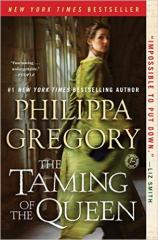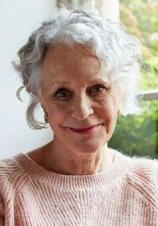Author Talk: August 28, 2015
For fans of historical fiction, Philippa Gregory needs no introduction; THE TAMING OF THE QUEEN is the latest in a long list of bestselling novels. It tells the fascinating story of Kateryn Parr --- King Henry VIII’s sixth and final wife --- a brilliant scholar and deeply religious woman who would outlive her husband and triumph over his domestic reign of terror. In this interview, Gregory reveals how she captures historical figures and events with such precision and immediacy, and why she thinks historians haven’t given Kateryn her due. She also discusses the queen’s love of language and publishing --- a love the author herself shares --- and why it’s important to write about women who were not inactive victims of male power.
Question: Lady Mary tells Kateryn “If you are a reader, you are already halfway to being a writer.” Do you agree? How did you decide to become a writer? Is your career the result of your love of reading?
Philippa Gregory: I became a writer rather by default. I was hoping to get a post teaching history in a university when the cuts in university funding meant there were no openings. While I was applying, and waiting, I started my first novel, WIDEACRE, and found that I loved writing. It was a huge success, and I have been a full-time professional writer ever since. My love of writing comes directly from my joy in reading. I don’t think you can write unless you have read widely and deeply.
Q: As a bestselling novelist, do you have any advice for aspiring writers? Is there anything you wish you had been told at the start of your writing career?
PG: I wish someone had told me that it would get easier. You learn your craft as you write, and you solve all sorts of technical difficulties as you go along. It becomes more and more enjoyable, too, and it’s really important to go with your heart. A novel comes because of a sort of inspiration, and you should follow it, however surprising and unlikely. It’s a gift, not a conscript.
Q: Booklist has praised your writing, saying, “Nobody does dynastic history like Gregory.” Can you tell us how you research your novels? In the course of researching Kateryn Parr, did you learn anything surprising that you incorporated into THE TAMING OF THE QUEEN? If so, can you tell us about it?
PG: I read extensively, everything that is newly published and all the older histories, many of them now forgotten and ignored. Then I bring to the story what I have learned from other research: how to locate the women when they are not mentioned in the histories, how to reconstruct their lives from a few clues, what some of the clues mean --- the clothes they draw from the wardrobe, their place at court. Kateryn Parr’s scholarship was a real surprise to me. I knew that she published, but I had no idea how significant her scholarly work was, nor that she was such a pioneer in women’s writing. I have tried to make that clear in THE TAMING OF THE QUEEN. Her study of theology and her commitment to religious reform is not especially interesting to the modern reader, but it is a key part of her character that I felt I must show.
Q: You’ve written extensively about Henry VIII’s wives. What first interested you in Kateryn Parr? Was writing about her different than writing about any of Henry’s other wives? In what ways?
PG: As one of the wives she’s well known and well recorded, unlike one of the mistresses, which makes it easier to re-create her days. But she was involved in meetings with the Lutheran and antipapist preachers, and in plots with others of the court to draw the king towards reform, so a lot of her work was secret and hidden. Foxe’s BOOK OF MARTYRS tells us a lot about this part of her work, but he is, of course, very much on the side of reform, so he is biased. I suspect that she was in love with Thomas Seymour when she married the king, but her feelings about him (or about being married to such a physically repellent older man) are completely secret and still unknown.
Q: Kateryn Parr is known as the first English queen to publish under her own name. As an author yourself, did you feel any kinship with her?
PG: I had to restrain myself from assumptions of kinship! She was a far greater scholar than I, a linguist and a woman of deep and regular religious practice. I understand, I think, her love of words, and I describe that drawing on my own experience, and I know, as she did, the joy of publishing something that starts its life as a wordless idea in your mind, and then becomes pages and goes out to other people to put ideas in their heads. This is thrilling work that we both have done. But Kateryn Parr was an independently thinking woman when it was dangerous to be a woman like that, publishing anonymously at first, studying in secret. She is a real heroine, while I have all the privileges of the Western women of the 21st century --- there’s no comparison.
Q: Kirkus Reviews lauds your novels, saying, “Gregory manages to keep us in suspense as to what will befall her characters…. Under [her] spell, we keep hoping history won’t repeat itself.” How do you address the challenge that comes with writing a story where the ending is already well known?
PG: I have experienced this challenge since THE OTHER BOLEYN GIRL, and I found, since then, that by writing the book in first person present tense I get an immediacy and a point of view that is that of the character and that obscures the knowledge of what is going to happen. If the reader can come with me into the here and now of the Tudor world, then they will know only the here and now and not the hindsight of history, which sucks drama and jeopardy from the story.
Q: Many of your novels center around the role that “powerless” women have, and THE TAMING OF THE QUEEN is no exception. Kateryn and Anne Askew are powerful figures in their own right, although they are discounted by many in the Tudor court. Why is it important for you to explore this theme?
PG: I didn’t realize at the start of my career that this would become a theme for me --- it’s grown out of the research. So many of the women that we think are “powerless” --- following the views of the early historians, all of them men, all of them mainly interested in men and male power --- were in fact in continual dialogue with power: gaining ground and losing it. In this novel we see Kateryn become Regent of England, the most powerful person in England, and also in danger of losing her life for thinking independently. I think all women in this period (and probably in all periods) make gains in their personal and political lives and lose them, regain power and experience danger.
This is the story of women’s history --- not one of unbroken oppression and passivity, not one of victimhood. I am drawn to write it because I am a radical historian, a woman, and because I believe it to be the truth --- or at any rate a more accurate account than the view of women as inactive victims of male power.
Q: Kateryn has been seen as a divisive figure in the Tudor court because of her interest in religious reform. Do you think that she is remembered fairly by historians? Why or why not?
PG: I don’t think she’s given true credit for her work as a scholar and reformer, because the big move to Protestantism comes with her stepson, Edward; the movement goes the other way with his heir, Mary; and then Elizabeth brings in the Protestant settlement and gets the credit for it. Kateryn is not recognized for her revolutionary religious views because there is less interest in religion now. I think she is largely dismissed by historians as the “last” wife, of Henry’s declining years, and Victorian historians mistook her for his nurse.
I would be very pleased if my novels contributed to a revision of all the wives of Henry. Kateryn is one of six very interesting, very diverse women, who were themselves part of a community of women who were constantly making progress and losing ground in their freedom. They were not feminists in the sense that they argued for women’s rights, but they were part of a self-aware community of women whose education and religion persuaded them that they were spiritually and intellectually the equal of men. Once a woman is free to speak to God directly, and not solely through a priest (a male, celibate priest), she sees that her soul is equal to that of a man and then --- hurrah --- the cat is out of the bag.
Q: Several of your bestselling works have been adapted into films and television series. What has the experience of seeing the adaptations been like? While you were writing THE TAMING OF THE QUEEN, were there any scenes that you found particularly cinematic? Can you tell us about them?
PG: I never think about filming when I am writing a novel --- the task of writing a novel is too absorbing to admit any diversions to other media. It’s always a pleasure when someone takes such an interest in the story that I have told that they want to retell it in another form, and it’s always a challenge to let it go fully into that other form and be reinterpreted. Some adaptations I like better than others --- like most people who are readers more than they are viewers, I tend to like novels best.
Q: What would you like your readers who are interested in the English monarchy to take away from THE TAMING OF THE QUEEN?
PG: I should like them to be aware of the wealth of talent and interest that women brought to English life and expressed in the ways that they were allowed. They are our foremothers and our heroines; they show what can be done in an oppressive world, and their lives suggest what we might do even in our own, easier circumstances.
Q: Are you working on anything now? Can you tell us about it?
PG: I am working on a new book set in the Tudor period. More than that I can’t say, as I don’t yet know!




